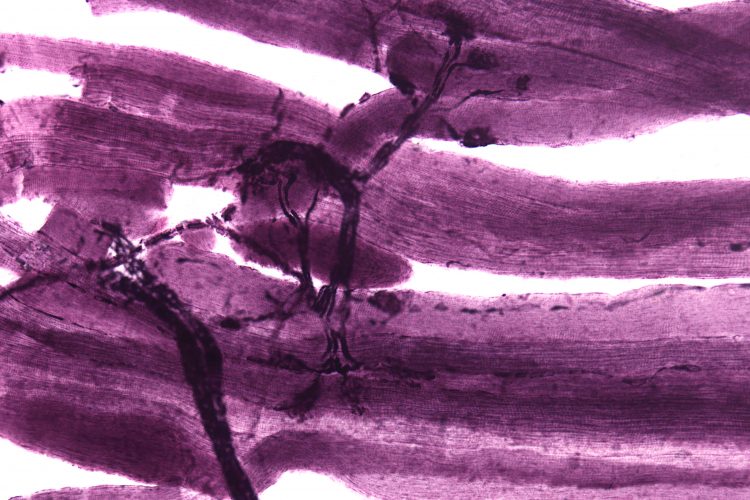Age-related decline in motor function could be prevented using gene therapy
Posted: 19 August 2020 | Hannah Balfour (Drug Target Review) | No comments yet
Enhancing neuromuscular junction (NMJ) formation using DOK7 gene therapy improved muscle strength and motor function in aging mice.


A microscopy image of neuromuscular junctions with projections from the neurons (grey/black) connecting to the muscles (purple).
In order to overcome some of the challenges presented by an aging society, researchers experimenting on aging mice have revealed that a neuromuscular junction (NMJ) formation-enhancing treatment could be used to overcome age-related decline in motor function and muscle weakness.
The group led by Professor Yuji Yamanashi of the University of Tokyo’s Institute of Medical Science, conducted experiments using aged mice to demonstrate that muscle denervation (motor neuron detachment from muscles) at the NMJ could be offset by an NMJ formation-enhancing treatment.
For movements to occur, precise control of skeletal muscle contraction via motor neurons is required. The NMJ, also known as the neuromuscular synapse, is the site at which motor neurons and skeletal muscles connect and its loss means that motor functions, including breathing, can stop. According to the team, degeneration of the neuromuscular synapse is associated with age-related motor impairment and therefore strategies to improve muscle innervation at aged NMJs may be an effective therapeutic strategy.
In their previous research, the team demonstrated that the muscle protein Dok-7 plays an essential role in NMJ formation and forced expression in muscles causes NMJs to enlarge. Moreover, therapeutic administration of an adeno-associated virus vector encoding human Dok-7 (AAV-D7 or DOK7 gene therapy) suppressed muscle denervation and enhanced motor activity in a mouse model of amyotrophic lateral sclerosis (ALS).
In their latest study, when the DOK7 gene therapy was given to aged mice it caused:
- Enhanced motor nerve connection
- Stronger response of skeletal muscles to motor neuron stimulation
- Improved muscle strength and motor function.
Yamanashi said: “In this new study with mice, NMJ augmentation treatment was shown to be effective for age-related motor impairment and muscle weakness, which are serious problems in an aging society. It has great social significance in terms of presenting the possibilities.”
The paper was published in iScience.
Related conditions
Muscle degeneration
Related organisations
University of Tokyo
Related people
Professor Yuji Yamanashi



